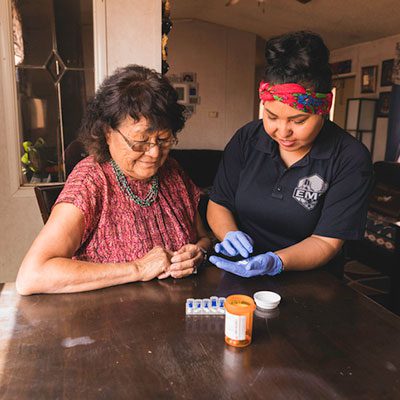Diabetes is an urgent problem for Native American communities. According to the most recent Centers for Disease Control and Prevention (CDC) statistics, nearly three times as many Native Americans have been diagnosed with diabetes than non-Hispanic white populations in the U.S. In fact, Native American diabetes rates are the highest among all U.S. racial and ethnic groups, and Native Americans are 2.3 times as likely to die from diabetes complications. Native Americans and diabetes clearly need more attention.
The prevalence of diabetes in Native American communities has caused devastating consequences for individuals and families. More effective identification and treatment could save thousands of lives and help entire communities. In this article, we will examine why diabetes is a problem for Native Americans, complications that can arise if left untreated, effective ways of treating and managing diabetes, and the importance of culturally sensitive diabetes care and education for Native Americans.
Why is diabetes a problem for Native Americans?
Historical, environmental, social, and genetic factors have contributed to diabetes among Native American communities. Factors include higher frequencies of poverty, obesity, physical inactivity, unhealthy diets, and limited access to health care.
Prior to the Indian Removal Act of 1830, Native Americans had thriving agriculture with an abundance of crops that supported good nutrition. After being removed from their land, Native Americans were forced to adopt a limited diet consisting mainly of canned meats, bread, beans, sugar, and coffee or tea. Despite efforts to improve access to better nutrition, food quality and quantity remained insufficient, causing malnutrition and hunger to become widespread.
Due to this major change in diet and other social determinants of health, many Native Americans began to experience diabetes, which was previously unknown to them. By the mid-1960s, Type 2 diabetes in Native American populations had become more prevalent, and by the 1990s diabetes had increased by 46% in Native Americans under the age of 35.
Treating diabetes and preventing complications
Identifying and treating diabetes in Native American populations is crucial, as early diagnosis and intervention reduce the risk of complications. Better diabetes management can significantly improve quality of life and help mitigate the economic burden of diabetes on families and communities.
Complications of diabetes can include heart disease, stroke, kidney failure, blurred vision, and blindness. One of the most concerning complications of diabetes for Native Americans is the increased risk of wounds caused by trauma or poor blood circulation. Diabetes slows the healing process and can cause severe infections, amputations, and a significant decline in overall health and wellbeing. Foot ulcers (open sores on the feet) can become infected and cause tissue damage. According to the Indian Health Service, Native Americans have nearly twice the rate of foot and lower limb amputations due to diabetes-related complications than the general population.
Effective diabetes management involves a combination of lifestyle modifications, medication management, and regular monitoring of blood glucose levels. Additionally, promoting quality wound care, education, and self-management can help prevent the progression of diabetes-related wounds and foot ulcers and reduce the risk of amputations in Native American populations.
The importance of culturally sensitive care
One of the challenges of providing effective diabetes care and education for Native Americans is the cultural diversity and complexity of these communities. Healthcare providers must be mindful of the cultural beliefs, traditions, values, and ways of life of Native American patients when delivering both care and education.
For example, incorporating traditional healing practices, storytelling, and community engagement can enhance the effectiveness of diabetes management and wound care interventions. Effective care for Native Americans aligns with a holistic view of health and may encompass physical, mental, emotional, and spiritual aspects.
Community-based diabetes prevention programs and culturally tailored dietary and physical activities and interventions have a greater likelihood of adoption, adherence, and success. Understandably, Native Americans may trust their families and elders more than they trust the health care system due to the generational and historical trauma, and discrimination they have experienced.
Culturally appropriate care also means ensuring access to affordable medications and supplies to meet the needs of Native Americans. Affordability and access are essential for promoting adherence to treatment regimens and improving health outcomes. A comprehensive approach must include cultural, educational, and resource components.
Watch the full captioned video on YouTube.
How diabetes programs and education are helping
Culturally tailored prevention and management programs can effectively reduce the risk of diabetes and its complications in Native American communities. For example, the federal Special Diabetes Program for Indians (SDPI) has helped support significant improvements in diabetes outcomes and reduced the incidence of diabetes-related complications among participating tribes.
Jonas Nguh, PhD, MHA, MSN received the American Association of Men in Nursing (AAMN)/DAISY Foundation Health Equity Award for 2023 for his work as a diabetes nurse educator with the Indian Health Service. In his role working to support the SDPI, he provides training, area meetings, and site visits along with higher-level administrative functions such as grant administration, technology, training, and leadership.
FEDS and DETS programs
Nguh established the American Indian Diabetes Collaborative, which created and implemented the Family Education Diabetes Series (FEDS) and Diabetes Education in Tribal Schools (DETS) programs at 20 sites across four Southwestern U.S. states. Together, these programs have successfully increased access to diabetes services and sustained outcomes at or near national targets for over four years.
- The FEDS program, a community-based participatory research project that supplemented standard diabetes care, features intergenerational and participant-led activities. After 21 biweekly sessions with over 1,800 adults participating in 50% or more of the sessions, 90% of the most active participants had metabolic control scores at or below the recommended level.
- The DETS program uses an evidence-based curriculum to educate youth about health, diabetes, science, and other topics. The program engaged 1,400 participants aged 7-20 in events such as food and activity journals, dancing games, yoga, and traditional dancing. More than half of the participants achieved lower BMI measures and 45% reported becoming more physically active.
Citizen health care model
Nguh underscores the important role of cultural awareness in the success of the FEDS and DETS programs. “We found that it is really, really important — because people can relate when they see somebody that looks like them or has gone through a similar experience that they, too, are going through, and they can begin to see someone that’s having positive outcomes,” he observed.
In addition to using culturally responsive strategies to support healthy lifestyles through avenues such as community theater, youth advocacy, and other activities, Nguh’s work features a citizen health care model to champion health equity and inclusion through community-centric programs. In the citizen health care model, community members help build their own health care. “[We are] not just engaging the patients, but the entire community as co-producers of health and health care. So, from an activated patient, we now become an activated community.”
As a proponent of equity and inclusion, Nguh also avoids speaking about diabetes as a deficit model. “I think the overall message is that we don’t frame it as a disease. We frame is as, ‘How can you improve the quality of your life?’ How can you improve your health — for yourself, your children, your family? We try to frame it in a positive way, because diabetes is a lifelong condition that, with proper management and things that you can do in your day-to-day life, you can live better, you can live longer, and you can live a positive life.”
With these intentional strategies, Nguh is optimistic about future progress and provides a successful model for how to achieve it.
This is the fourth article in our series examining challenges in Native American health care.

Evidence-Based Government Healthcare Training Solutions
Relias can help your government organization improve patient care and outcomes in your communities with our proven, data-driven solutions. We support your clinicians on their journey to competency — and your organization’s ability to provide effective, highly-reliable care.
Explore solutions →






